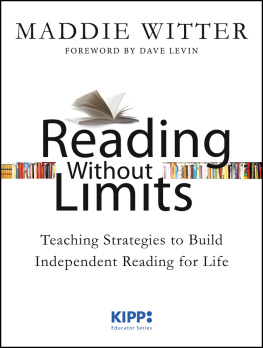Bonnie Burns - How to Teach Balanced Reading and Writing
Here you can read online Bonnie Burns - How to Teach Balanced Reading and Writing full text of the book (entire story) in english for free. Download pdf and epub, get meaning, cover and reviews about this ebook. year: 2006, publisher: SAGE Publications, genre: Children. Description of the work, (preface) as well as reviews are available. Best literature library LitArk.com created for fans of good reading and offers a wide selection of genres:
Romance novel
Science fiction
Adventure
Detective
Science
History
Home and family
Prose
Art
Politics
Computer
Non-fiction
Religion
Business
Children
Humor
Choose a favorite category and find really read worthwhile books. Enjoy immersion in the world of imagination, feel the emotions of the characters or learn something new for yourself, make an fascinating discovery.
- Book:How to Teach Balanced Reading and Writing
- Author:
- Publisher:SAGE Publications
- Genre:
- Year:2006
- Rating:5 / 5
- Favourites:Add to favourites
- Your mark:
How to Teach Balanced Reading and Writing: summary, description and annotation
We offer to read an annotation, description, summary or preface (depends on what the author of the book "How to Teach Balanced Reading and Writing" wrote himself). If you haven't found the necessary information about the book — write in the comments, we will try to find it.
Any teacher can use this book regardless of the reading program a district may be using. It brings the various practices of reading and writing together in a practical and useful way.
-Betty Ann Collinge, Kindergarten/First Grade Teacher
Green Acres Elementary School, North Haven, CT
This books major strengths include straightforward writing, clear discussion of topics, excellent graphic samples, strong attention to a balanced perspective, and practical ideas.
-Jennifer Trujillo, Assistant Professor, Teacher Education
Fort Lewis College
The book is easy to follow and very accessible. It is not too esoteric or philosophical, yet includes important theory and knowledge about learning. The suggestions are excellent, relevant, and inclusive.
-Karen Heath, Literacy Coordinator
Barre Schools, VT
Use these practical strategies to help students develop strong reading and writing skills!
Reading is a complex process. And in todays increasingly diverse classrooms, each student has unique learning needs. In the face of these challenges, how can teachers ensure that all students develop essential literacy skills?
How to Teach Balanced Reading and Writing provides practical, research-based strategies for all aspects of literacy education. Presenting best practices in an easy-to-use format, literacy expert Bonnie Burns supplies guidance for providing direct instruction in phonics, using authentic texts, building word recognition, strengthening comprehension, and implementing writing across the curriculum. Aligned with the National Reading Panel Report (2000) and Reading First legislation, this book offers strategies to use with students at all developmental levels.
This second edition has been extensively revised to include
- Strategies for assessing phonemic awareness
- Techniques for developing fluency
- Increased attention to the needs of diverse learners
- Additional instructional activities in every chapter
Because of its flexibility, this book is suitable for both novice and experienced teachers. Its friendly, accessible format also makes it an ideal text for preservice teachers and students in education courses.
Bonnie Burns: author's other books
Who wrote How to Teach Balanced Reading and Writing? Find out the surname, the name of the author of the book and a list of all author's works by series.

















